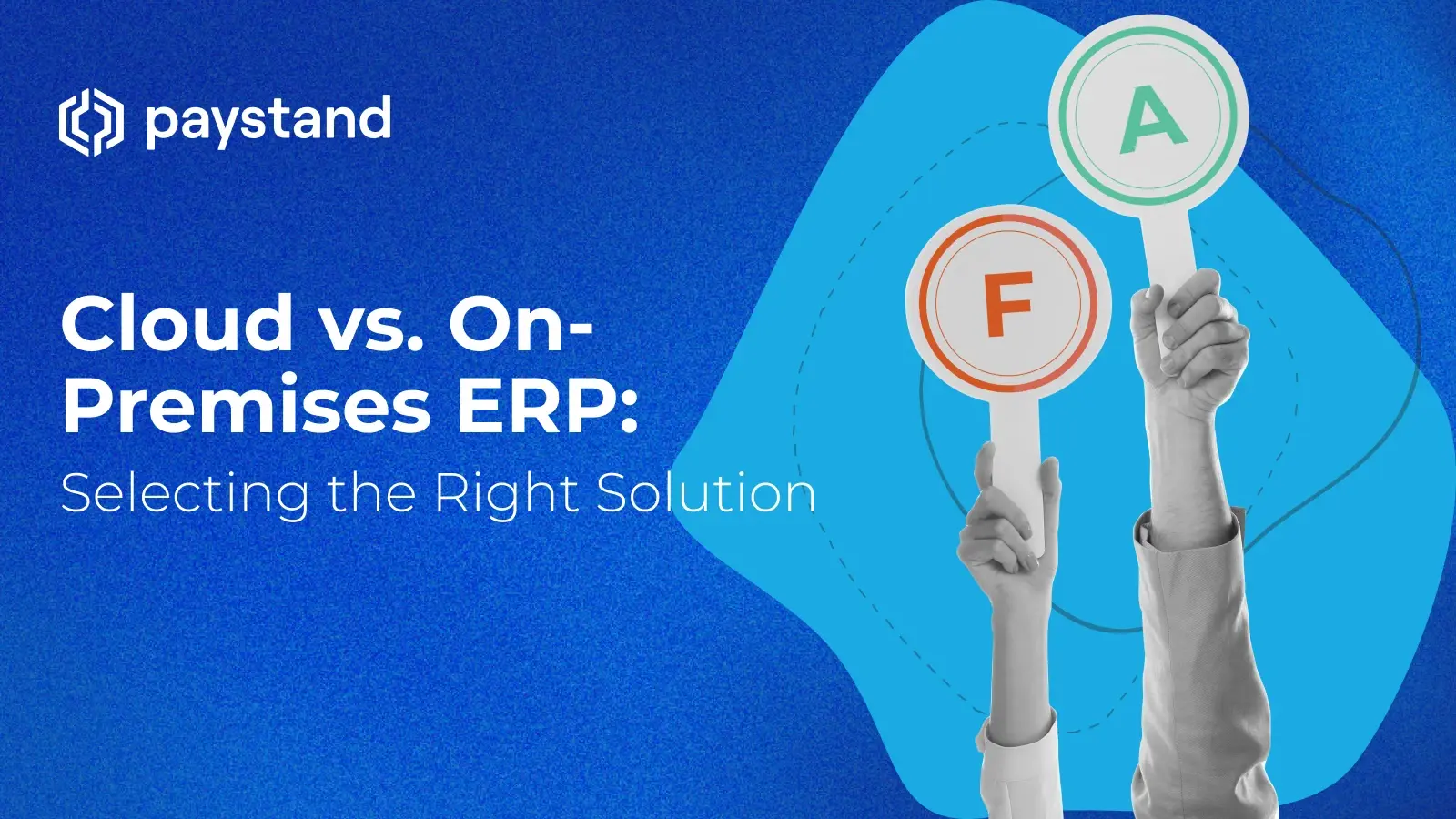Cloud vs. On-Premises ERP: Selecting the Right Solution

Table of Contents
- What is on-premises ERP?
- What is cloud ERP?
- Cloud vs. on-premises ERP: strategic differences
- Which is better: cloud-based ERP or on-premises?
- Empowering businesses with Paystand and modern ERP
Key Takeaways
- On-premises ERP systems offer full control and security but come with high upfront costs, manual maintenance, and slower innovation.
- Cloud-based ERPs deliver agility, faster implementation, and real-time automation features like AI forecasting and digital payments, making them ideal for modern business needs.
- While regulated industries may still prefer on-prem or hybrid models, cloud ERP is emerging as the dominant choice due to its scalability, lower total cost of ownership, and remote accessibility.
- Automation, blockchain, and crypto payment rails drive next-gen ERP trends, which reduce fraud, cut costs, and enable always-on finance operations.
- Paystand accelerates ERP modernization by embedding a zero-fee, blockchain-powered B2B payment network into leading ERP platforms, transforming finance departments into strategic growth engines.
In today’s world of digital payments, businesses can no longer afford clunky, outdated finance systems that lead to late payments and cash flow headaches. Modern customers expect fast, frictionless transactions, while finance teams demand real-time visibility into every invoice.
Choosing the right ERP is urgent. Old ERP platforms often trap companies in manual workflows, siloed data, and endless IT maintenance. In contrast, newer cloud-based solutions leverage AI, automation, and cryptocurrency rails to transform business operations.
This guide will explain both models, highlight key differences, and show how leading systems embrace cloud innovation to drive growth.
What Is On-Premises ERP?
An on-premises ERP system is hosted and managed on local servers or a datacenter. In this model, the business buys a one-time license and installs the ERP on internal hardware. Because the company controls every deployment aspect, it has complete control over data and security. On-premises ERP was traditionally the standard: think of it as buying a server and ERP license upfront, like purchasing a device outright.
On-premises ERP enables customization, allowing the IT team to adapt the system, integrate legacy software, and maintain compliance with strict security policies. Industries managing sensitive data, such as government or healthcare, favor this model for greater control. Data security is handled internally; with data behind the corporate firewall, you control every security measure.
However, they incur high initial costs for servers, software, and IT staff, as maintenance and upgrades are managed internally. Scaling requires new hardware and licenses, and innovation is slow due to manual testing. A legacy on-premises system may cause inefficiencies and delayed invoices if the business lacks robust IT support or needs to implement ERP payments quickly.
What Is Cloud ERP?
A cloud ERP system is hosted by the vendor and delivered via a SaaS model over the internet. Companies subscribe to the ERP and access it through a web browser without local installation. The vendor’s remote data centers manage the software, maintenance, and automatic updates. They function like any online service: you log in, and everything works as the vendor manages the servers.
Cloud-based ERP systems provide accessibility anywhere. Authorized users can access the system from any device with an internet connection, making it ideal for remote teams and global operations. Implementation is faster; businesses can often have a cloud ERP running in weeks instead of months. Importantly, cloud ERP changes costs from capital expenses to operating expenses: no large hardware purchases, just a predictable monthly subscription.
Modern cloud ERP solutions leverage advanced technology, offering real-time analytics, AI forecasting, and automation to improve workflows. They can automate invoicing, cash applications, and payment reminders, expediting B2B payments and reducing late payments. Businesses quickly access new features as vendors regularly deploy enhancements (such as AI modules or mobile apps) at no extra cost.
Cloud vs. On-Premises ERP: Strategic Differences
| Feature | On-Premises ERP | Cloud-Based ERP |
|---|---|---|
| Deployment and Hosting | The IT team retains control over infrastructure and security on local servers. | The externally hosted site requires internet access and a web browser; no physical hardware is needed. |
| Upfront Cost and TCO | It needs high initial costs, but becomes cheaper over time as internal IT manages maintenance. | The external site requires internet access and a web browser; no hardware is needed. |
| Maintenance and Updates | Company-managed. The organization must install updates and patches, which can be slow. | Vendor-managed updates deploy automatically, minimizing downtime and keeping the ERP current. |
| Scalability and Flexibility | Scaling up needs new servers or licenses due to hardware limits. High customization is possible as you control the code. | Elastic resources (CPU, storage) expand on demand for workload spikes. |
| Data Control and Security | On-premises data ensures maximum governance and security, relying on your investments: firewalls, encryption, and audits. | Cloud providers with strong encryption and compliance secure data. Trust vendors' security, as many cloud ERPs exceed mid-size companies' resources. |
| Access and Connectivity | Accessible via office network or VPN. Reduced internet reliance means fewer failure points, but remote access requires extra setup. | It is available online for remote collaboration and B2B payments. However, a stable connection is crucial; outages can prevent access. |
| Customization and Integration | Deep ERP integrations offer high customization, but custom coding needs skilled IT staff and complicates future upgrades. | Customization is limited to vendor tools. Most cloud ERPs use APIs for service connections, simplifying setups. |
Comparing these factors shows that cloud and on-premises ERP have pros and cons. On-premises provides control and predictability, while cloud offers agility and automation. The best choice depends on business needs and strategy.
Which Is Better: Cloud-Based ERP or On-Premises?
Cloud-based ERP systems dominate today. Modern businesses demand agility, collaboration, and quick digital payments, which are the strengths of the cloud model. Companies using cloud ERP see faster rollouts, fewer late invoices, and easier compliance updates. Cloud ERP supports strategic goals like remote work, AI insights, and leaner IT budgets.
On-premises ERP remains valuable. Large enterprises with legacy systems or in regulated industries often prefer it for specialized needs, sometimes adopting a hybrid approach. For example, they might run core financials on-premises while using cloud modules for commerce. Such solutions attract teams needing full control and can manage the related overhead.
The ERP vs. on-premises debate is evolving. Many on-prem vendors offer cloud options, and vice versa. The choice isn’t one-size-fits-all. Businesses shouldn’t view on-premises as permanent. Legacy ERP can hinder organizations with outdated systems, manual reconciliation, and siloed data, leading to inefficiency and unpaid invoices. In contrast, cloud ERP enables automation and integration.
Modern trends suggest that AI, machine learning, and advanced analytics are essential to ERP suites. Blockchain improves ERP systems, while crypto rails facilitate 24/7 payments. For instance, blockchain in ERP lowers costs by removing middlemen and preventing fraud. These innovations boost business efficiency and competitiveness.

Empowering Business with Paystand and Modern ERP
The era of fragmented, on-premises finance systems is ending. Today’s visionary companies turn to integrated, cloud-based ERP solutions to supercharge efficiency and profitability. With Paystand, the transformation accelerates further: Paystand’s blockchain-powered, zero-fee B2B payment network is built as a SaaS on modern ERP platforms. This means businesses can collect payments instantly, automate reconciliation, and entirely sidestep the hidden fees of traditional payment rails. Late payments become rare as AR teams deploy digital invoicing, automated reminders, and flexible checkout options embedded in their ERP.
Integrating Paystand with your ERP, like Sage, Microsoft Dynamics or NetSuite, transforms your financial software into a growth engine. Paystand’s integrations and the NetSuite Marketplace connect payments to business operations, resulting in a reimagined back office that improves cash flow, enhances finance strategy, and ultimately increases profitability.
Don’t let outdated systems hold you back: explore cloud ERP solutions and empower your ERP with Paystand’s modern payment options today.





